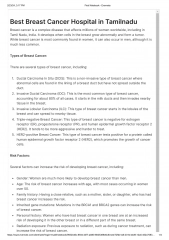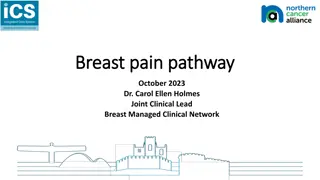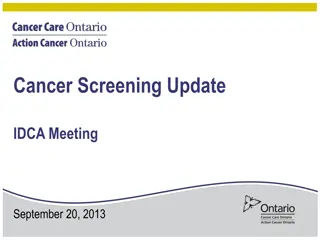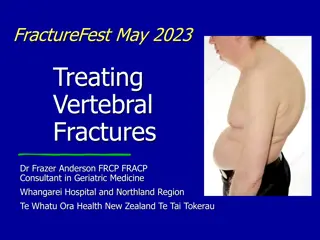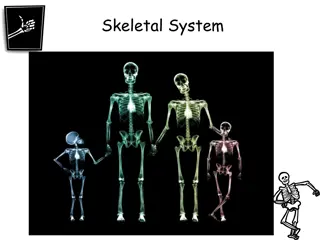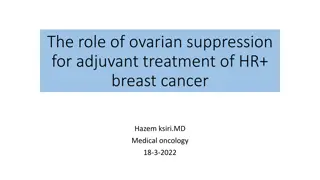Denosumab Prevents Bone Loss in Premenopausal Women with Breast Cancer
Denosumab, an anti-RANKL monoclonal antibody, effectively prevents bone loss in premenopausal women with ER-positive early-stage breast cancer undergoing aromatase inhibition therapy. The study highlights the benefits of using denosumab to preserve bone mineral density and strength, potentially improving quality of life and fracture-free survival.
Download Presentation

Please find below an Image/Link to download the presentation.
The content on the website is provided AS IS for your information and personal use only. It may not be sold, licensed, or shared on other websites without obtaining consent from the author.If you encounter any issues during the download, it is possible that the publisher has removed the file from their server.
You are allowed to download the files provided on this website for personal or commercial use, subject to the condition that they are used lawfully. All files are the property of their respective owners.
The content on the website is provided AS IS for your information and personal use only. It may not be sold, licensed, or shared on other websites without obtaining consent from the author.
E N D
Presentation Transcript
Denosumab prevents bone loss and microarchitectural deterioration in premenopausal women with breast cancer receiving estradiol suppression therapy: a randomized controlled trial Ramchand SK, Ghasem-Zadeh A, Hoermann R, et al. J Clin Oncol 2024 Jul 2:JCO2302309. Epub ahead of print Background & methods Results Conclusions Messaggi chiave Powered by
MESSAGGI CHIAVE L inibizione delle aromatasi (AI) associata a soppressione della funzione ovarica (OFS) migliora la sopravvivenza libera da malattia in pazienti in premenopausa con carcinoma mammario precoce (eBC) ER+, accelerando per la perdita ossea. Denosumab (DMAB) un anticorpo monoclonale anti-RANKL che ha dimostrato di produrre una soppressione quasi completa del rimodellamento osseo AI-indotto nelle donne in postmenopausa. stato condotto uno studio randomizzato, in doppio cieco, su DMAB rispetto a placebo in 68 donne in et premenopausale con eBC ER+ avviate ad AI + OFS. Nell arco di 12 mesi, rispetto a placebo, DMAB ha prevenuto efficacemente e in modo statisticamente significativo la diminuzione della densit minerale ossea (BMD) (totale, corticale e trabecolare) a livello di tibia distale, come pure la rigidit stimata e il carico di rottura, con risultati simili per il radio distale. stata inoltre prevenuta la riduzione della BMD a livello di rachide lombare, anca totale e collo femorale. Malgrado alcuni limiti, quali la breve durata del follow-up e le dimensioni limitate del campione, lo studio evidenzia come l uso profilattico di DMAB sia in grado di preservare la BMD, la microarchitettura ossea e la forza stimata, con possibili effetti positivi sulla qualit della vita e sulla sopravvivenza libera da frattura. Powered by
PURPOSE Suppression of ovarian function and aromatase inhibition (AI) increases disease-free survival in premenopausal women with estrogen receptor (ER)-positive early-stage breast cancer but accelerates bone loss. We therefore hypothesized that suppressing bone remodeling using denosumab (DMAB) would prevent bone loss in these women. Powered by
METHODS In a 12-month double-blind randomized trial, 68 women with ER-positive early-stage breast cancer commencing ovarian function suppression and AI were randomly assigned to 60 mg DMAB (n = 34) or placebo (PBO; n = 34) once every 6 months (at 0 and 6 months). Volumetric bone mineral density (BMD), microarchitecture, and estimated bone strength of the distal tibia and distal radius were measured using high-resolution peripheral quantitative computed tomography, and spine and hip BMD were measured using dual-energy X-ray absorptiometry at 0, 6, and 12 months. The primary end point and treatment effect was the mean adjusted between group difference (MAD; [95% CI]) in distal tibial total volumetric BMD over 12 months, with a single p value tested over all time points. The study is registered with the Australian New Zealand Clinical Trials Registry (anzctr.org.au; identifier: ACTRN12616001051437). Powered by
RESULTS Intention-to-treat analysis included all 68 randomly assigned women. Over 12 months, compared with PBO, DMAB prevented the decrease in distal tibial total BMD (MAD, 20.8 mg HA/cm3[95% CI, 17.3 to 24.2]), cortical BMD (42.9 mg HA/cm3[95% CI, 32.1 to 53.9]), trabecular BMD (3.32 mg HA/cm3[95% CI, 1.45 to 5.20], p = 0.004), estimated stiffness (11.6 kN/m [95% CI, 7.6 to 15.6]), and failure load (563 N [95% CI, 388 to 736]). Findings were similar at the distal radius. Decreases in BMD at the lumbar spine (MAD, 0.13 g/cm2[95% CI, 0.11 to 0.15]), total hip (0.08 g/cm2[95% CI, 0.07 to 0.09], and femoral neck (0.06 g/cm2[95% CI, 0.05 to 0.07]) were also prevented. All p <0.001 unless otherwise noted. Powered by
CONCLUSIONS Treatment with DMAB at commencement of estradiol suppression therapy preserves BMD, bone microarchitecture, and estimated strength, and is likely to increase fracture-free survival. Powered by


